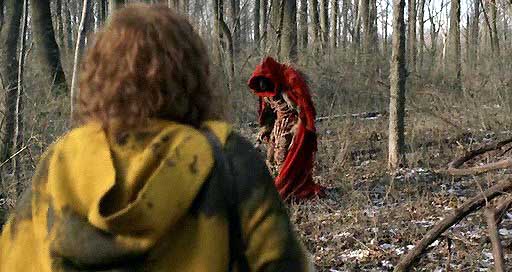

|
The Village
5 out of 10 |
 |
|
Life and Death in Dullsville Do you remember sitting in English class and being forced to read complex dull literature that you had to deconstruct and write essays about? Similar to a 1950's Twilight Zone or Ray Bradbury tale, M. Night Shyamalan has created a profound, intense and suspenseful follow-up to previous hits "Sixth Sense," "Unbreakable" and "Signs." Based on an almost Orwellian idea and script that is thoughtful and unique, it contains all the elements including the anticipated but still thought provoking twist ending for which Shyamalan is famous. "The Village" tells the story of a religious, tightly knit farming community in Pennsylvania who, believing that all forms of violence are utterly wrong, live in terror of the woods that surround them. Overwhelmed by fear, the residents agree to never cross into the forest, and so exist in total isolation in an almost simplistic innocence, until a young man from the community, Lucius Hunt (played by Joaquin Phoenix) asks for permission to break their oath and venture into the outside world. With luminous performances by Bryce Dallas Howard (daughter of director Ron Howard) as blind villager Ivy, the ever philosophical William Hurt as Ivy's father community leader Edward Walker and The Pianist's Adrian Brody as the haunting Noah Percy, it is a powerful story, operating on several different levels and is richly symbolic both visually and narratively. Exploring primitive elements and emotions of anger, love, jealousy and fear, Shyamalan creates a thriller through a fear of the unknown that has an almost palpatable atmosphere of tension and suspense throughout. Filled with scenes both nightmarish and unsettling, even in the most innocent and happiest of moments, it is a picture shrouded in a heavy and troubling feel of something strangely amiss. Late in the day, it is remodeled as a love story, but fails to capitalize on this central theme as a result of a poor and wooly introduction of the central two characters, despite a sweeping violin accompaniment by virtuoso Hilary Hahn that would have been more worthy of a greater epic. Purpose-built in 11 weeks in an open field for the production, the period village of Covington Woods is a realistic setting that matches the lavish historical costumes created by veteran designer Ann Roth ("The English Patient"). Once again, as demonstrated in his previous movies, Shymalan regards colour, shot and sound as critical to the core of his work. In close co-operation with cinematographer Roger Deakins ("Rob Roy," "The Ladykillers"), it is filmed in a simple, almost dreamlike style, capturing both the terrifying and poigniant moments of the lives of the residents. Toned in ever present vivid red and yellow, amplifying the conflicting forces of action and cowardice, the cinematography often makes "The Village" resemble an oil painting by Vermeer or Whistler, but sadly through the consequential neglect of the dialogue, it often leaves it also as flat and as lifeless. Despite deeply disturbing elements and some frightening moments, many of the early scenes are long, tedious and humourless and with only a few moments of action, it is often overly burdened by moral messages. These characteristics in a sense add to the cold, morally upright and mysterious nature of the village, but enable less of a connection to the characters which is only salvaged by strong performances by the cast. Too wooden to be an art house film and too deep to be light entertainment, "The Village" is likely to be too dry to gain popular appeal.
Film Critic: Jennifer M Lillies
|
|